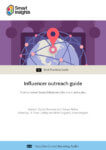When influencer marketing and branded content work together, both sides benefit in the end
Influencer marketing and branded content: They’re useful tools on their own, but they are far more effective within a strategy that treats them as complementary pieces of a stronger whole. Unfortunately, advocates for influencer marketing and branded content tend to see one another as adversaries.
The first group champions influencer marketing’s ability to give a brand street cred with third-party associations. As little as people sometimes trust brands, an endorsement from an influencer can go a long way toward building audience trust, and for niche audiences and micro-influencers, the effect is even more pronounced.
Download our Individual Member Resource – Influencer outreach guide for marketing professionals
This practical guide shows you how to use tools to find and interact with influencers on the best social media platforms for outreach, that’s Twitter, LinkedIn, Facebook and more.
Access the Influencer outreach guide for marketing professionals
Lovers of branded content, however, believe that control over the message is a powerful tool. They prefer to fine-tune stories until those tales become effective vessels for content outreach. Where influencer advocates believe the voice is more important than the message, content advocates believe that a great message is effective — regardless of the source
But in the heat of competing philosophies, both sides have overlooked something important: Both branded content and influencer marketing are effective tactics, but they’re even more effective when used together. If digital marketers set aside their differences and look at their goals, they may finally understand that a blended approach is the best strategy.

Strength in marketing unity
By using influencer marketing and branded content together, brands can ensure the content they want to share reaches audiences through trusted influencers. That means no more worrying about the effectiveness of the message and no more concern over the trustworthiness of the speaker. The brand curates the communication, the influencer delivers through an impactful channel and the brand comes off as more relevant and worthwhile than ever.
To see this in action, consider the recent partnership between Headspace and the NBA. An app designed to facilitate meditation and better sleep doesn’t sound like a natural NBA partner, but this odd couple made it work beautifully.
In exchange for more than 7,000 Headspace memberships for players and personnel, the NBA produced guided training content with the platform and featured Headspace on owned media channels. The NBA made basketball more accessible to casual fans by inviting them to try some of the advanced training strategies their favorite players use to prepare for games. Headspace, meanwhile, appealed to a wider audience that might not be familiar with the benefits of meditation.
The NBA’s branded content on Headspace’s influencer channel is an ingenious path toward more engagement with the league. Even though the NBA retains control over its messaging, its presence on Headspace allows it to rely on the clout of the platform to add credibility to the content. What’s more, Headspace benefits from the notoriety of the league and its players, as the co-created content is shared through the NBA’s social media platforms.
3 ways to blend branded content and influencer marketing
Instead of fueling the fire of argument, why not make the most of two powerful strategies? Take advantage of these three tactics to find the perfect balance of branded content and influencer marketing:

1. Fold an influencer campaign into a larger branding strategy
Look for influencers who can work within the wider context of the brand’s objectives, not just influencers who know how to hawk a certain product. This is not an easy process, but it is a necessary one. Only influencers with audiences that match the brand’s target buyer personas should make the cut.
Don’t look at follower counts alone. Focus on candidates who engage with their audiences and know how to tell a story. Mercedes-Benz, for instance, found great success by working with Instagram’s beloved wolf dog Loki. The brand leveraged Loki’s online fame into a wider campaign that included an immersive video through the Colorado mountains, connecting Mercedes-Benz with wonder and adventure for an audience that is in love with those ideas.
2. Use different influencers for the same branded content
Who made the rule that influencers and branded content had to be paired for life? Single-influencer campaigns can be effective, but brands can spread their influence further by partnering with multiple voices inside the same niche. The point of this practice is to make users feel like the brand is plugged into the community and relevant to the people within it.
For example, Shopee Indonesia once worked with 200 influencers at once to promote a limited-time sale. That may be a bit much for branded content in most cases, but the theory remains sound. Identify the market to address, then work with a platoon of influencers to make the most of the engagement opportunity.
3. Give influencers creative freedom with branded content
Lovers of branded content just cried foul, but they shouldn’t worry. This is not about handing off the brand’s image to strangers. Rather, it is about allowing featured influencers to tell the stories they are so good at telling and placing the brand at the center of the tale.
When tech company Lenovo wanted to promote a new tablet computer, it didn’t hand every influencer a script. Instead, the company distributed products to popular influencers and asked them to spend (and film) their time with the new devices. Mommy blogger Kileen, for instance, wrote a blog post showcasing how Lenovo’s Yoga 3 Pro helped her fulfill her "modern mom" duties. Because this is what her blog centers around, the content felt authentic, and at the end of the post, she gave her followers the chance to win their own Yoga 3 Pro by promoting a giveaway contest.
Final thoughts
Branded content advocates constantly worry that influencers will get messages wrong, but influencers gained their popularity for a good reason. They are masters of audience engagement. People trust them and listen to what they have to say, so give them a chance to work that same magic on branded content.
Disagreements between branded content advocates and influencer lovers will continue, but just because the sides have different priorities doesn’t mean they can’t get along. Cooperation opens many more doors than suspicion. Influencer marketing and branded content are a marketer’s match made in heaven, and with the right strategy, the two tactics together become more than the sum of their parts.
Sadie Schabdach is Chief Content Officer at
Mitchell, a leading integrated PR firm that creates real connections between businesses, brands, and people. Mitchell is the flagship PR agency of the Dentsu Aegis Network, which is the 2017 and 2018 MediaPost Holding Company of the Year.









